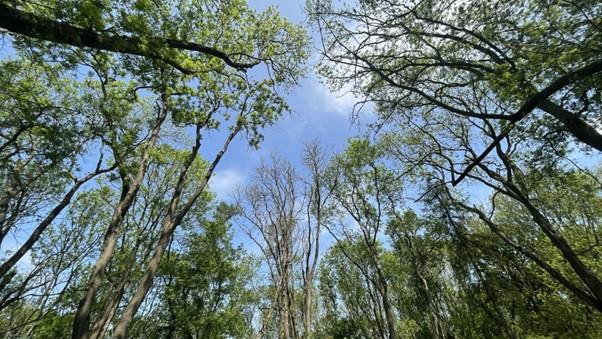A student researcher at the Environmental Change Institute has devised a way of predicting how the fungal disease ash dieback will affect tree mortality rates. The chronic fungal disease attacks European ash and causes leaf loss and crown dieback in infected trees.
The findings, published in Forest Ecology and Management, will make it possible to forecast forest health generally and offer solutions to other damaging pathogens – microorganisms such as bacteria, fungi and viruses that spread to new habitats and pose a risk of disease to the plants or animals of that ecosystem.

Haoran Wu, is the lead author of the study: Evaluating the impact of an invasive pathogen on tree population decline: An evidence-based modelling approach.
Working alongside co-authors Dr Cecilia Dahlsjö, Senior Researcher, and Professor Yadvinder Malhi, Ecosystems Research Programme Leader at the ECI, his study, was carried out at Wytham Woods, which has been owned and maintained by the University of Oxford since 1942. The Woods are often quoted as being one of the most researched pieces of woodland in the world, and their 1000 acres are designated as a Site of Special Scientific Interest.
Haoran said: “Studies show that new forest pathogens are doubling approximately every 11 years, many causing widespread damage to forest ecosystems worldwide. Modelling future forest loss caused by diseases is challenging, as it requires a sophisticated understanding of the pathogen-hosts-surrounding interactions.
“Our model predicts that the ash population will decline by around 26 % in the next 10 years and maintaining a 15% resistant tree population could maximise the potential of removing disease-prone genotypes by natural selection.”
The researchers say that by scaling up the methodology to other invasive forest pathogens it is possible to forecast forest health which will help manage forest areas.
Haoran added: “In this study, we present a model that will; forecast the ash population decline rate in the short term; report the uncertainty of the forecasts caused by data errors; and also assess how alternative scenarios (e.g. presence of resistant hosts) may affect mortality rates.
“Our model is systematically justified by an evidence-based modelling framework, which allows us to determine the most appropriate level of model complexity. This methodology is scalable to other ecological communities, making our paper a pioneering study that investigates how ecological models, crafted through systematic review, can effectively bridge the gap between scientific evidence and practical management applications.”
Haoran, is in his final year of his MPhil in Biodiversity, Conservation, and Management at the Environmental Change Institute (ECI) at the University of Oxford. His focus is tree pests and pathogens on global forests. He begins a DPhil at the ECI in October when he will be scaling up his MSc research from ecological impacts of ash dieback to a variety of forest pests and pathogens.
Read the full article in Forest Ecology and Management: Evaluating the impact of an invasive pathogen on tree population decline: An evidence-based modelling approach
Find out more about Haoran Wu and his work on Google Scholar and ResearchGate.

